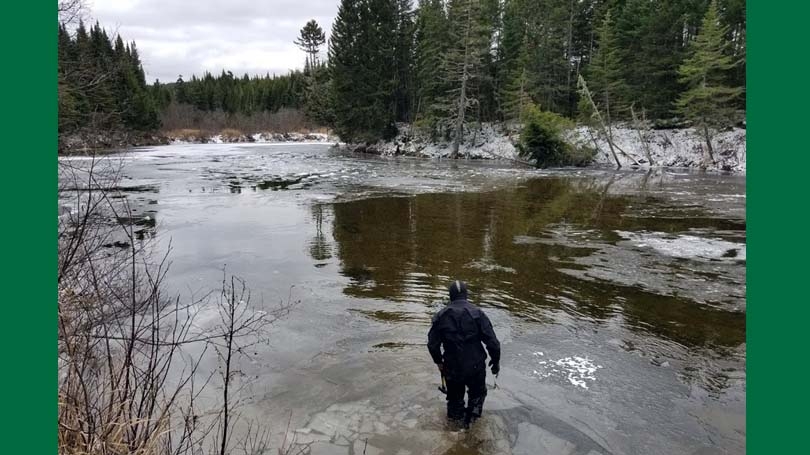
Keith Fritschie in the suit purchased using funds from the Alumni Research Award, which allowed him to log many hours researching the spawning habitat of the Dead Diamond River brook trout in the College's Second Grant
In mid-October, among a parade of fallen leaves, I snorkeled the reach of the Dead Diamond River where Second College Grant historian Jack Noon ’68 thought I might find spawning fish. Dorsal vermiculation and yellow spots on a green background helped brook trout hide among the gravels, woody debris, and dappling sunlight that patterned the riverbed. Thankfully, after 20 minutes of searching, the white fins and blaze orange bellies of male brook trout revealed their spawning location. In just a 50 x 50-foot patch of river, I counted 30 brook trout hovering over half as many nests dug into the riverbed. Six hundred to 1,000 eggs likely lay protected within the gravels of each nest. After a few minutes of watching males spar, females dig, and cannibalistic juveniles eat eggs, I hauled myself onto the bank to log this spawning patch into the GPS. I’d return to this patch at the end of the spawning season to record the final number of nests here, and once more in late November to measure the intragravel temperature and oxygen conditions adjacent to each nest.
I’ll spend at least the next three falls like this, snorkeling the Dead Diamond River through Dartmouth’s Second College Grant in search of spawning brook trout. For migratory fish species, monitoring spawning patches is often a good way to track general trends in a population through time. Moreover, the average size and quality of these spawning patches, their distance from one another and from important fry nursery areas, and the behavior of spawning fish within these patches all have important consequences for the ultimate size a population can reach.
As a member of Dr. Kathryn Cottingham’s lab in the Ecology, Evolution, Ecosystems, and Society graduate program, the main purpose of my PhD research is to address the question: does limited spawning habitat control how large the Dead Diamond brook trout population can get? I’ll address this question by identifying spawning patches in the Dead Diamond, classifying the form(s) of habitat selection behavior exhibited within these patches, quantifying the population’s spawning habitat preferences, and determining whether other high-quality spawning habitats are available, but currently unused, in the river.
To begin these tasks, I logged 225 hours in the water in autumn 2017, covering 30 cumulative river miles in water temperatures ranging from 55° to just over 32° Fahrenheit. In all, we identified five spawning patches in the mainstem Dead Diamond River, monitored three patches daily during the spawning season (which in 2017 was October 1 - October 24), counted approximately 220 total nests, recorded 50 hours of video to extract information on fish size and behavior, and measured habitat characteristics at 350 point locations to determine spawning habitat needs. Data analysis is underway with the help of two Dartmouth undergraduate students: Alexa Wing, ’20 and Andrew Li, ’20.
Mainstem spawning habitat is likely to play a major role in the population dynamics of Dead Diamond brook trout; however, what about those many tributaries across Dartmouth’s Second College Grant? In healthy, highly-connected stream networks like the Dead Diamond watershed, these tributaries might contribute substantially to the population’s success by providing nursery habitat for juveniles or additional spawning opportunities for adults. To complement my dissertation research on mainstem-spawning fish, I am lucky to join a team of New Hampshire Fish and Game, Trout Unlimited, and Dartmouth researchers studying fish movement between mainstem and tributary habitats. This research employs radio tracking devices, known as Passive Integrated Transponder (PIT) tags, to track individual fish through time and space. Ultimately, the Dead Diamond system might serve as a reference to guide restoration efforts in other parts of the state. This project is entering its second phase of fieldwork this spring and our progress can be tracked at www.ammotu.org/projects.
I used Dartmouth’s Alumni Research Award to purchase a waterproof drysuit for these projects. This suit keeps me safe and warm at uncomfortably cold water temperatures! Thank you to the alumni who support graduate research at Dartmouth through this funding opportunity.